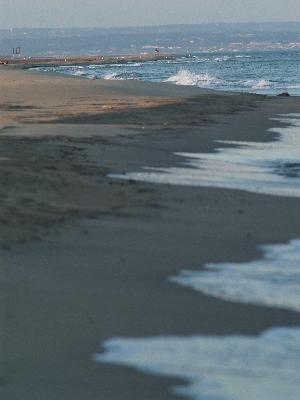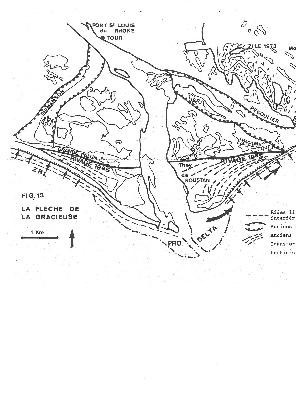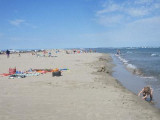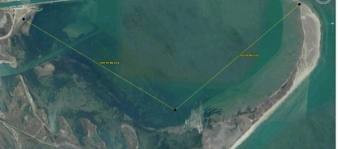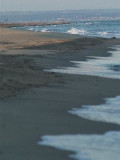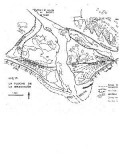They de la Gracieuse and They de Roustan
Leisure Water sports Beach / Bathing AreaPresentation
They de la Gracieuse: long sand spit of 6 km to the west limit of the Gulf of Fos.
- Location:
Continuation of the Napoleon beach.
- Size: 1,387.85 ha.
- They de la Gracieuse: long sand spit of 6 km to the west limit of the Gulf of Fos. It forms a natural breakwater and is driven mainly by the sandy flows from the Rhone, which provoked the grounding of shipwrecks causing a deviation from frontal "folds" to the Gulf and the anchorage of Carteau. The spit itself is the result of the convergence in the 19th century of four Theys: Roustan, at the mouth of the Grand Rhone, Eugene, the Balancelle and the Gracious ("they" means fast evolving sand spit incorporating a deltaic headland or an adjunct sedimentary body).
This area includes all of the They de Roustan and the They de Gracious dunes. This is a supralittoral environment where the vegetation cover is mainly formed by ammophiletum, agropyretum, Salicornietum fruticosae and Thero-Brachypodion for environments less exposed to salt.
- Flora and natural habitats:
The flora and vegetation are composed of several species and psammophytic and halophytic formations near sansouire, with some interesting elements: Spartina versicolor formation, Echinophora spinosa and Pancratium maritimum dunes, temporary brackish waters at Ruppia or Zostera and especially Matthiola tricuspidata, known in mainland France only in two site; the latter and that of the Giens Peninsula. Schoenoplectus pungens populates the banks of the Rhone and plays a major role in the alluvium and which also exist on ZNIEFF facing the They de la Palissade.
- Fauna:
They de la Gracieuse et le They de Roustan boast four major species and 12 remarkable species. They host an interesting parade with colonies of night herons and little egrets, as well as Bittern singers, Anatidae including Red-crested Pochards, raptors including Western Marsh-harrier, waders including the Redshank, the Eurasian Oystercatcher, the Black-winged Stilt, the Avocet, the Tern and the Little Tern and sparrows including the Greater Short-toed Lark and the Savi's Warbler mostly related to salt marshlands and wetland formations. The otter, becoming very rare in France and in Provence, is present in this area.
Continuation of the Napoleon beach.
- Size: 1,387.85 ha.
- They de la Gracieuse: long sand spit of 6 km to the west limit of the Gulf of Fos. It forms a natural breakwater and is driven mainly by the sandy flows from the Rhone, which provoked the grounding of shipwrecks causing a deviation from frontal "folds" to the Gulf and the anchorage of Carteau. The spit itself is the result of the convergence in the 19th century of four Theys: Roustan, at the mouth of the Grand Rhone, Eugene, the Balancelle and the Gracious ("they" means fast evolving sand spit incorporating a deltaic headland or an adjunct sedimentary body).
This area includes all of the They de Roustan and the They de Gracious dunes. This is a supralittoral environment where the vegetation cover is mainly formed by ammophiletum, agropyretum, Salicornietum fruticosae and Thero-Brachypodion for environments less exposed to salt.
- Flora and natural habitats:
The flora and vegetation are composed of several species and psammophytic and halophytic formations near sansouire, with some interesting elements: Spartina versicolor formation, Echinophora spinosa and Pancratium maritimum dunes, temporary brackish waters at Ruppia or Zostera and especially Matthiola tricuspidata, known in mainland France only in two site; the latter and that of the Giens Peninsula. Schoenoplectus pungens populates the banks of the Rhone and plays a major role in the alluvium and which also exist on ZNIEFF facing the They de la Palissade.
- Fauna:
They de la Gracieuse et le They de Roustan boast four major species and 12 remarkable species. They host an interesting parade with colonies of night herons and little egrets, as well as Bittern singers, Anatidae including Red-crested Pochards, raptors including Western Marsh-harrier, waders including the Redshank, the Eurasian Oystercatcher, the Black-winged Stilt, the Avocet, the Tern and the Little Tern and sparrows including the Greater Short-toed Lark and the Savi's Warbler mostly related to salt marshlands and wetland formations. The otter, becoming very rare in France and in Provence, is present in this area.
Accessible for disabled
Practical information
- Parking :
- Parking nearby
- Environments :
- Town outskirts
- Visits :
- you can visit it
- Tourist itinerary :
- Tourist itinerary
- Park :
- Camargue Regional Nature Park
Facilities, services, amenities
- Leisure facilities :
- Beach
Contact
They de la Gracieuse and They de Roustan
13230
Port-Saint-Louis-du-Rhône
Phone : +33 4 42 86 01 21
Destination
They de la Gracieuse et They de Roustan
13230
Port-Saint-Louis-du-Rhône
GPS coordinates
Latitude : 43.351272
Longitude : 4.880118

